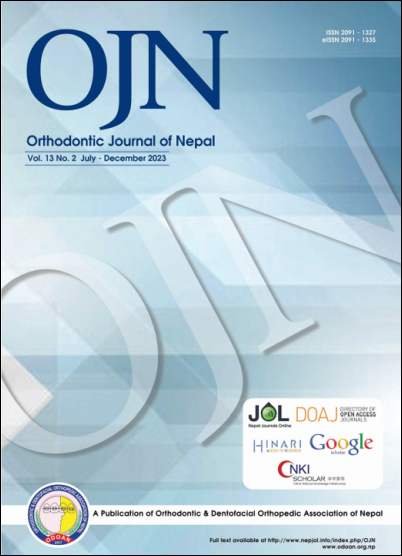“The TA loop” better force delivery through better design
DOI:
https://doi.org/10.3126/ojn.v13i2.58951Keywords:
Finite element analysis, FEM, frictionless mechanics, loops in Orthodontics, Finite element analysis, FEM, frictionless mechanics, loops in orthodontics,TA ( Tarun Anu) loop.Abstract
Introduction: This study evaluates and compares stress distribution and deformation generated on the periodontal ligament, cortical and cancellous bone by a novel loop design, the TA (Tarun Anu) loop used for anterior teeth retraction and compare it with the conventional Mushroom loop using finite element analysis (FEM).
Aims and Objective: Evaluation of the efficacy of a novel loop design named as TA loop with the conventional Mushroom loop (M loop) using FEM.
Materials and method: Finite element models of both the loops and maxilla and mandible was created using ANSYS Software and for geometric modelling, SolidWorks Software was used. The loading condition was designed to mimic retraction forces determined from two different activations and the results were obtained.
Results: FEM affirmed that the stresses generated by the TA loop were within the permissible range which could be taken up by the roots and the surrounding tissues without causing any deleterious effect. The TA loop includes two helices on either side of the horizontal section, resulting in increased wire length and enhanced force delivery.
Conclusion: Significant variations in stress distribution and deformation were observed between the two loops, highlighting the TA loop’s superior efficiency in achieving a consistent force delivery due to increased range of actions.
Downloads
Downloads
Published
How to Cite
Issue
Section
License
Copyright (c) 2024 Orthodontic & Dentofacial Orthopedic Association of Nepal

This work is licensed under a Creative Commons Attribution 4.0 International License.
Copyright © held by Orthodontic & Dentofacial Orthopedic Association of Nepal
- Copyright on any research article is transferred in full to the Orthodontic & Dentofacial Orthopedic Association of Nepal upon publication in the journal. The copyright transfer includes the right to reproduce and distribute the article in any form of reproduction (printing, electronic media or any other form).
- Articles in the Orthodontic Journal of Nepal are Open Access articles published under the Creative Commons CC BY License (https://creativecommons.org/licenses/by/4.0/)
- This license permits use, distribution and reproduction in any medium, provided the original work is properly cited.




